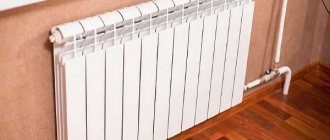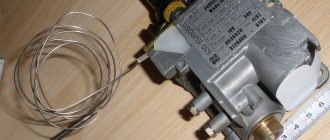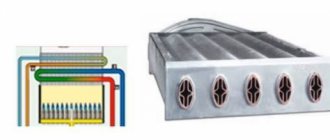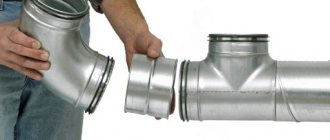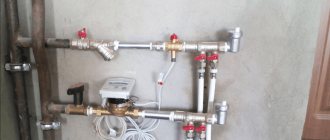Millions of consumers think about saving money thanks to a gas meter, but realize that the costs of purchase, installation and possible repairs are also high. Do you recognize yourself among them? Do you want the gas meter to pay for itself in 2-3 years? It's simple.
If you do not resort to unauthorized actions, there will be no fine. If you maintain the distance from the gas meter within normal limits, it will work correctly. If you buy a quality device, you will not need to replace it.
We have provided information on installing a gas meter, including exact distance standards. The master will do everything for you, but you should still supervise the installation. Read the article and you will understand why. Your convenience depends on this.
Rules for installing a gas meter in an apartment. Requirements for installing a gas meter
Measuring the volume of gas used can reduce your monthly utility costs. The absence of a meter in a house or apartment obliges consumers to pay for services at a single tariff - for the volume of gas that, according to statistics, is consumed by one person over a certain period. From this article you can learn the rules for installing a gas meter in an apartment and the basic requirements for installation.
The average gas pressure in a gas pipeline is how much
To study the operating mode of gas pipelines, gas pressure is measured at least twice a year, during the period of highest flow (in winter) and lowest (in summer). Based on the measurement results, maps of pressures in gas networks are drawn up. Using these maps, those areas where there is the greatest gas pressure drop are determined.
On the approach to the city, gas distribution stations (GDS) are built, from which gas, after measuring its quantity and reducing the pressure, is supplied to the city's distribution networks. The gas distribution station is the final section of the main gas pipeline and is, as it were, the border between the city and main gas pipelines.
During the technical inspection, they monitor the oil level in the gearboxes, gearbox and counting mechanism, measure the pressure drop across the meters, and check for tight connections of the meters. Meters are installed on vertical sections of gas pipelines so that the gas flow is directed through the meter from top to bottom.
The gas arrives at the receiving point under a pressure of 0.15-0.35 MPa. Here, its quantity is first measured and then sent to receiving separators, where mechanical impurities (sand, dust, corrosion products of gas pipelines) and condensed moisture are separated from the gas. Next, the gas enters gas purification unit 2, where hydrogen sulfide and carbon dioxide are separated from it.
To check the operating mode of gas pipelines and identify areas with the greatest pressure drop, gas pressure measurements are taken. For measurements, gas control points, condensate collectors, inlets into houses or directly gas appliances are used. On average, one measuring point is selected for every 500 m of gas pipeline. All work on measuring gas pressure is carefully planned and carried out according to special instructions, which are approved by the chief engineer of the trust or office.
In Fig. Figure 125 shows a gas supply diagram for a large industrial enterprise. Gas from the high-pressure gas pipeline through a shut-off device / in the well is supplied to the central gas control point GRP 2. It measures gas flow and reduces it. In this case, high-pressure gas is supplied to workshops No. 1 and 2, medium pressure gas is supplied to workshops No. 3 and 4 and the boiler room, and low pressure gas is supplied to the canteen (through the GRU). If there are a larger number of workshops and they are located at a significant distance from the central gas distribution center, cabinet-mounted gas distribution units 7 can be installed in the workshops, ensuring stability of the gas pressure in front of the burners of the units. When gas consumption is high, gas flow metering units can be installed in workshops to monitor rational and economical gas combustion.
To select part of the main gas and transfer it through outlet gas pipelines under the required pressure to intermediate consumers, gas distribution stations (GDS) are built. The GDS is equipped with pressure regulators (spring or lever action), dust collectors, condensate collectors, installations for odorizing gas (i.e. giving it an odor) and measuring the amount of gas supplied to the consumer, shut-off valves, connecting pipelines and fittings. The mass of piping pipelines and fittings for gas distribution stations with a throughput capacity of 250–500 thousand m per hour reaches approximately 20–40 tons.
Criterias of choice
Today, several types of meters are used: membrane (diaphragm), turbine, rotary, and also vortex, so there really is plenty to choose from.
In Russia, membrane-type devices are most often installed on household gas networks. This equipment is equipped with an elastic membrane. The main advantage of these devices is reliability, simplicity of design and relatively small measurement error. Electronic meters are more accurate due to built-in monitoring sensors.
Gas meters are also divided according to how much gas they consume in one hour. This parameter is determined by studying the technical parameters of all gas appliances located in the apartment. Consumption of a classic four-burner gas stove is on average 1.56 m 3 /hour, column - 2.5 m 3 /hour. Summing up the total consumption will allow you to find out the power of the required meter.
When choosing a rotary, volumetric or electronic gas meter, you should pay attention to the fact that gas can be supplied either from the left or from the right. It is important to consider this point when purchasing.
When purchasing, it is imperative to check the manufacturing date of the selected model, since the interval between verifications is determined not by the day of installation, but by the date of manufacture. If more time has passed since the factory check than is required before the next test, then some difficulties may arise with the service life.
How to choose a gas meter
Despite the fact that in order to approve the project for installing a metering device, it is necessary to provide a data sheet for the flow meter, the choice of equipment should be made only after consultation with specialists. You should definitely inquire about the list of approved devices, since unlicensed devices will not be put into operation.
In order to select a flow meter, you should take into account its technical characteristics, especially paying attention to two criteria: throughput and type of device.
The first criterion depends on the number and power of gas appliances installed in the house. For one slab, for example, a throughput of 1.6 m3/hour is sufficient. This parameter is indicated on the front panel and can be found out by looking at the value indicated after the letter “G”, that is, in this case you need a device marked G1.6.
The choice of meter depends on the throughput of gas appliances. For example, if for a gas stove it ranges from 0.015 to 1.2 m3/hour, then a meter with parameters of 1.6 m3/hour is optimal. If several devices are installed and operated, then the minimum values of the least powerful and the maximum data of the highest consumption should be taken into account. But you need to take into account that choosing an ideal flow meter for such a requirement is often an impossible task, so maximum values are taken into account. For example, if the minimum consumption of the stove is 0.015 m3/hour, and the maximum throughput of the boiler is 3.6 m3/hour, then you should purchase a meter marked G4.
However, it is imperative to take into account the fact that the meter will be allowed to be installed if the deviation in the minimum value does not exceed 0.005 m3/hour. Otherwise, it may be necessary to install separate metering devices and, as a result, maintain two separate personal accounts.
Main types of household gas meters
When choosing a meter, you should definitely take into account its type, which determines the principle of its operation, as well as the accuracy of the data obtained. Based on this criterion, individual consumers can choose devices:
- membrane These gas meters are distinguished by their low price, high reliability and completely reliable values. But they are very noisy devices;
- rotary devices. These devices are popular because of their compact size and fairly low price, but they have a short service life and are not highly accurate in the measurements obtained;
- ultrasonic devices. These meters are electronic devices and have high measurement accuracy. They are quite compact, silent and can be integrated into an overall system for remote data transfer.
Also, when choosing a gas meter, you should take into account its installation location, since these devices are right- and left-handed. It is also necessary to take into account what section of the pipe the installation will be carried out on: horizontal or vertical. You also need to decide on the location of the gas meter: in the house, in a warm, heated room, or on the street. In the latter case, you should buy a device with thermal correction, as evidenced by the letter “T” on the front panel of the device, indicated next to the throughput of the device.
Particular attention should be paid to the date of manufacture of the meter, since it is the starting point for determining the calibration interval, which is individual and ranges from 3 to 15 years.
Installation Requirements
A gas meter is a rather complex device; certain requirements must be met when installing it. Each metering device must include a passport - a document that contains information about the device and the requirements for its installation and operation.
There are general requirements and rules for installing a gas meter in an apartment:
- The distance from the device to the floor surface is 1600 mm.
- The distance from the heating boiler or gas stove to the device is 800 mm.
In addition, this equipment can be installed not only indoors, but also from the street. In the latter case, it is advisable to protect the meter from direct exposure to sunlight, strong temperature changes, and moisture. Such impacts can significantly reduce the operational life of the metering device.
When installing individual devices, the passport may indicate additional rules for installing a gas meter in an apartment, which apply to a specific model and differ from the general requirements.
Device and principle of operation
The design of an indirect heating boiler is a tank with a heat exchanger installed inside. Heating of water occurs as a result of the transfer of heat from the coolant from the heat source (most often a gas boiler) to the heated water. Thermal energy losses are reduced by insulating the tank walls with heat-insulating material.
Some models of indirect heating boilers provide several heat exchangers, which allows you to receive heat from different sources. Distilled water or ethylene glycol, propylene glycol, antifreeze and other special liquids are used as a coolant. The water heater device includes pipes for coolant, cold and heated water, and some models have pipes for installing a temperature sensor and recirculation.
Using the principle of indirect heating makes it possible to rationally use energy with a slight increase in its consumption. The specified temperature regime is maintained with minimal energy costs due to the division of the coolant flow. One part of it goes to the coil, the other goes into the heating system, and the waste liquid is returned to the boiler.
Required documents
For installation you will need the following sample list of documents:
- Ownership of the premises where the metering device will be installed.
- Identification.
- Equipment passport.
- If the device has not yet been purchased - passports for all gas equipment installed in the room (boiler, stove, etc.), to determine the power and load when choosing a meter.
- Floor plan of a living space, house.
This is an approximate list of documents, so when you finally decide on installing a gas meter, it is advisable to clarify the exact list on the spot.
Maintenance of gas meters
According to the maintenance agreement between the consumer and the gas distribution company, the latter is obliged to periodically monitor not only the metering device, but also the gas pipeline, as well as all devices connected to it.
The purpose of such control is to prevent emergency situations, therefore it includes:
- visual inspection of equipment;
- checking the tightness of connections and the operating condition of devices;
- testing for traction;
- carrying out minor repairs and maintenance of working units;
- detection of gas leaks, etc.
An important aspect of maintenance is monitoring the serviceability of devices. If problems are identified, the specialist makes a verdict to replace the equipment, even if its inspection period has not yet arrived. It should be noted that the cost of replacing a gas meter
, although it affects the consumer’s wallet, is completely justified, since not only the accuracy of accounting, but also the safety of people depends on the functioning of the device. It should also be noted that when the deadline for inter-verification occurs or when repairs are necessary, the consumer often prefers to replace the old meter with a new device. The reason for this decision is obvious and is related to the fact that dealing with these issues is often more expensive and time-consuming than simply installing a new gas meter.
You can order the installation of gas meters from ours by filling out an application on the website rosschet.ru.
Installation instructions
Rules for installing a gas meter in an apartment:
- First of all, you need to write an application to the gas service, which indicates the place of registration, the full name of the owner, as well as the postal address of the place where you plan to install the meter. After this, a technician should come to you, who will inspect the gas equipment in your apartment or house and tell you which meter you should purchase. The “technical conditions” voiced by the master will allow us to develop a project. As a rule, this type of work is performed by the gas service itself.
- Buy equipment in accordance with the “technical specifications” received from the master. Household metering devices (intended for apartments or houses) differ from each other by their “nominal value” - the amount of energy that they pass per unit of time. For an apartment in which only a stove is installed, a meter that passes 2.5 m 3 of gas per hour is suitable.
- Contact the gas service again, where they will issue an invoice, and after payment, a technician will come and install the meter you purchased. After the gas meter is installed in the house, it will be necessary to obtain its passport. Sometimes the mark is put by the same master, sometimes you have to contact the gas service for this.
- Then you need to submit an application to the same gas service to seal the meter. After this procedure, you must be issued a certificate, which must be presented at the unified cash settlement center at your place of residence. Thus, you will begin to pay for gas supply using the new system, taking readings from the meter yourself.
What to do if the device breaks down
Any mechanical device can fail over time. Gas meters also do not escape this fate.
Breakdowns may vary depending on the type of meter:
- If we talk about electronic means of metering gas consumption, digital values are not reflected on the screen, or they are viewed, but only in fragments;
- for other types - the meter may freeze in place (this is noticeable visually), or there is a slight gas leak in the places where the meter is attached.
If, however, any problems are observed in the operation of the device, they can be eliminated in several ways. Regardless of when the specialist discovered a violation of the sealing of the accounting device, when he is called by the owner of the apartment or during the next medical examination, a report is drawn up.
In it, a representative of the organization indicates the identified fact of violation. When this happens, the owner of the equipment will be required by law to pay the company for the resource consumed, but according to the standards, this is an order of magnitude higher than payment according to indications.
Payment is calculated for the last six months of using the resource. By analogy with this technique, resource consumption is calculated when there is no metering device.
Please note! If the seal remains intact, but the gas engineer, during a routine inspection, discovers that the meter is faulty, you will also have to pay for gas according to the standard for the last 6 months.
It is believed that if the consumer did not report an obvious breakdown, he deliberately concealed the fact of incorrect recording of resource consumption.
A message about recalculation of the amount due to a violation will be sent to the consumer within 30 days. The company is obliged to notify about the recalculation and calculate the amount due.
If a malfunction of the device is discovered by the homeowner, and this is reported to the service company, a specialist arrives on site, determines that the seal is in place, and records the fact of the malfunction.
Here, calculation of consumption, based on approved standards, will be made only from the moment a malfunction is identified until the installation of another serviceable device.
Basic installation requirements
Despite the fact that gas meters in a private home are not installed by the consumer himself, it is necessary to familiarize yourself with the basic installation requirements. And in addition to the above rules, there are others.
- After completing the installation of the metering device, it must be sealed.
- It is important that the gas meter diagram not only corresponds to the installation location, but is also agreed upon by gas service experts.
- The installed equipment must be certified.
- When carrying out welding work, the gas supply in the apartment must be turned off.
- Installation work is carried out only by certified specialists.
- Work must be carried out in compliance with safety regulations.
How to hide pipes?
Don’t forget that there are communications running towards the column that will also need to be hidden. Be sure to check out our article “5 Ways to Hide a Gas Pipe.”
- paint the pipes, it’s effective and inexpensive;
- disguise the pipe as a roof rail;
- use hanging furniture to hide communications;
- make a box and run pipes there;
- as a last resort, move the pipes with the help of a gas service.
vote
Article rating
Installation of gas meters is the law!
In accordance with Law No. 261-FZ “On increasing energy efficiency and energy saving...”, adopted in 2009, gas meters must be installed in every home. And there is nothing bad or terrible about this, because we must pay for the quantity consumed, and not for the norm, which is determined by the number of registered people.
After all, different apartments and houses have different energy consumption, some have more, some have less. Most owners who installed metering devices felt savings on their wallets.
Article 13, paragraph 5.1. states that the installation of gas meters (Law No. 261-FZ) must be carried out by the owners of apartment buildings before January 1, 2015.
How to properly install a gas flow meter
It would seem that after deciding to install a meter, the first step in this direction should be the choice of a gas meter
, and this is partly true, but you should still start by choosing the organization that you plan to entrust to carry out installation work and put the flow meter into operation.
It is important to know that installation of gas meters cannot be done on your own, even if you have experience, skills and the necessary tools. Russian Government Decree No. 410 dated May 14, 2013 clearly states that such installation work can only be carried out by gas distribution companies and licensed organizations that have received the appropriate accreditation by concluding agreements with direct gas suppliers. For example, our specialists are ready to quickly and efficiently carry out all types of work on the installation and commissioning of gas meters, and to take advantage of this offer, we suggest filling out an application on the website rosschet.ru.
Once a contractor company has been selected, it is necessary to conclude a maintenance agreement with it. Next, fill out an application for installation of the device, to which photocopies must be attached:
- documents confirming the right of ownership of real estate;
- technical certificates of the premises;
- homeowner's passports;
- technical documentation for all gas appliances installed in the house;
- maintenance agreement signed in advance;
- meter data sheet.
Additionally, but also mandatory, you must present certificates and statements from your personal account confirming the absence of debt on gas payments.
Next, the application is approved and, after its approval, the consumer receives the appropriate referral. And then, to install metering equipment, he can contact specialists at the regional operational service or commercial organizations licensed to perform the relevant work.
ORDER A SERVICE FROM ACCREDITED COMPANIES
Installation cost
In principle, any metering device is the property of the person who owns the apartment. Accordingly, the customer must reimburse not only the cost of the meter, but also the installation work.
There are a number of factors that can affect the overall cost. Let's look at them:
- For whose money will the device be purchased?
- The need for welding work or its absence.
- The length of communications for the output of the metering device.
- The number of devices in the apartment that consume gas (boiler, gas stove, water heater).
If we talk about the specific cost, then installing a gas meter with one gas stove will cost on average 4000-5000 rubles.
Source: fb.ru
Types of gas meters and their characteristics
Gas meters are special devices designed to record the consumption of natural or liquefied gas. The types of such devices are presented in the table.
| Based on throughput | Based on the operating principle |
| Household | Turbine |
| Rotary | |
| Utilities | Diaphragm |
| Industrial | Membrane |
The main characteristic of gas meters is their throughput. This indicator allows you to determine how much of a resource can pass through the counter within a certain time. This number is indicated in the device labeling.
For example: if the meter says G4, this means that its throughput is 4 m3/h. The installation of the device must be carried out in a system within which the total demand for “blue fuel” of all household devices located there does not exceed the indicated figure.
Another important feature of each device is the total duration of its operational period. The average service life is 20 years or more. The countdown is carried out not from the moment the meter is installed, but from the date of manufacture at the factory.
